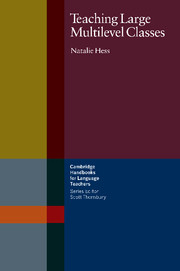Book contents
- Frontmatter
- Contents
- Dedication
- Thanks and acknowledgements
- Introduction
- 1 Getting to know our students
- 2 Motivation and activation
- 3 Reviewing while maintaining interest and momentum
- 4 Dealing with written work
- 5 Working well in groups
- 6 Individualizing and personalizing student work
- 7 Making students responsible for their own learning
- 8 Establishing routines and procedures
- Bibliography
- Index
- Frontmatter
- Contents
- Dedication
- Thanks and acknowledgements
- Introduction
- 1 Getting to know our students
- 2 Motivation and activation
- 3 Reviewing while maintaining interest and momentum
- 4 Dealing with written work
- 5 Working well in groups
- 6 Individualizing and personalizing student work
- 7 Making students responsible for their own learning
- 8 Establishing routines and procedures
- Bibliography
- Index
Summary
How to make best use of this book
Check the table of contents, the index, and the headings for activities you think are likely to be most useful to you, scan these, and make a note on where, when, and how you will use these activities.
Keep the book handy in a place where you normally do your lesson planning. Since most of the activities are easy to set up, you will want to refer to this book especially when your time is limited and you need a quick idea to incorporate into the next lesson.
Although you will probably do the activities as described at first, you will eventually start embroidering on them and change them to fit into your own menu of teaching strategies. That is a sign that they have really become your own. The aim of this book is actually just that – the expansion of your own teaching repertoire.
What is a large multilevel class?
There are, of course, many very different notions of what constitutes such a class. In the language institute where I taught for many years, twenty was considered a large class. Students there were carefully graded into seven levels of proficiency, yet teachers often complained about the great difference between the students who talk fluently but inaccurately, and those who read and write well yet cannot manage to produce a single coherent spoken sentence.
Information
- Type
- Chapter
- Information
- Teaching Large Multilevel Classes , pp. 1 - 15Publisher: Cambridge University PressPrint publication year: 2001
